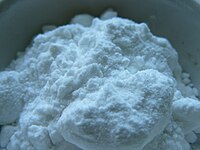This is an old revision of this page, as edited by LegacyOfValor (talk | contribs) at 20:44, 5 February 2012 (updated thermochem properties & cite). The present address (URL) is a permanent link to this revision, which may differ significantly from the current revision.
Revision as of 20:44, 5 February 2012 by LegacyOfValor (talk | contribs) (updated thermochem properties & cite)(diff) ← Previous revision | Latest revision (diff) | Newer revision → (diff) | |
 | |
 | |
| Names | |
|---|---|
| Other names Potassium chlorate(V), Potcrate | |
| Identifiers | |
| CAS Number | |
| 3D model (JSmol) | |
| ChemSpider | |
| ECHA InfoCard | 100.021.173 |
| EC Number |
|
| PubChem CID | |
| RTECS number |
|
| UNII | |
| UN number | 1485 |
| CompTox Dashboard (EPA) | |
InChI
| |
SMILES
| |
| Properties | |
| Chemical formula | KClO3 |
| Molar mass | 122.55 g/mol |
| Appearance | White crystals or powder |
| Density | 2.34 g/cm |
| Melting point | 356 °C |
| Boiling point | 400 °C decomp. |
| Solubility in water | 7.19 g/100 ml (20 °C) 57 g/100 mL (100 °C) |
| Solubility | insoluble in acetone, liquid ammonia |
| Refractive index (nD) | 1.40835 |
| Structure | |
| Crystal structure | monoclinic |
| Thermochemistry | |
| Std molar entropy (S298) |
143 J·mol·K |
| Std enthalpy of formation (ΔfH298) |
−391 kJ·mol |
| Hazards | |
| NFPA 704 (fire diamond) |
 |
| Flash point | 400 °C |
| Lethal dose or concentration (LD, LC): | |
| LD50 (median dose) | 1870 mg/kg |
| Related compounds | |
| Other anions | Potassium bromate Potassium iodate |
| Other cations | Ammonium chlorate Sodium chlorate Barium chlorate |
| Except where otherwise noted, data are given for materials in their standard state (at 25 °C , 100 kPa).
| |
Potassium chlorate is a compound containing potassium, chlorine and oxygen atoms, with the molecular formula KClO3. In its pure form, it is a white crystalline substance. It is the most common chlorate in industrial use. It is used
- as an oxidizing agent,
- to prepare oxygen,
- as a disinfectant,
- in safety matches,
- in explosives and fireworks,
- in cultivation, forcing the blossoming stage of the Longan tree, causing it to produce fruit in warmer climates.
Production
The compound is industrially produced by passing chlorine into the hot milk of lime, subsequently adding the potassium chloride (Liebig process). The electrolysis of KCl water solution is also used sometimes, then the chlorine formed at the anode reacts with KOH in situ. As KClO3 solubility in water decreases significantly when cooling, it can be simply isolated from the reaction mixture.
Can be produced in small amounts by disproportionation a sodium hypochlorite solution followed by metathesis reaction with potassium chloride:
- 3 NaOCl → 2NaCl + NaClO3
- KCl + NaClO3 → NaCl + KClO3
Can also be produced by passing chlorine gas into a hot solution of caustic potash:
- 3Cl2(g) + 6KOH (aq) → KClO3 (aq) + 5KCl (aq) + 3H2O(l)
Uses

Potassium chlorate was one key ingredient in early firearms percussion caps (primers). It continues in that application, where not supplanted by potassium perchlorate.
Chlorate-based propellants are more efficient than traditional gunpowder and are less susceptible to damage by water. However, they can be extremely unstable in the presence of sulfur or phosphorus and are much more expensive. Chlorate propellants must be used only in equipment designed for them; failure to follow this precaution is a common source of accidents. Potassium chlorate, often in combination with silver fulminate, is used in trick noise-makers known as "crackers", "snappers", "pop-its", or "bang-snaps", a popular type of novelty firework.
When mixed with a suitable fuel, it may form an explosive material, a so-called Sprengel explosive. The hygroscopic and slightly weaker sodium chlorate is sometimes used as a safer and less expensive substitute for potassium chlorate. In World War I, mixes of potassium chlorate with plasticizers (such as wax) were the most common type of plastic explosive used, often filling grenades and other munitions. When used in explosives as an oxidizer, the explosive is low order meaning it burns rapidly rather than explodes. When mixed with a plasticizer, it may become high order, requiring a blasting cap (generally a commercial #8) to detonate properly. Potassium chlorate is rarely used in explosives now, as it is considered too sensitive for most uses.
Potassium chlorate is often used in high school and college laboratories to generate oxygen gas ; it is a far cheaper source than a pressurized or cryogenic oxygen tank. Potassium chlorate will readily decompose if heated in contact with a catalyst, typically manganese (IV) dioxide (MnO2). Thus, it may be simply placed in a test tube and heated over a burner. If the test tube is equipped with a one-holed stopper and hose, warm oxygen can be drawn off. The reaction is as follows:
- 2 KClO3(s) → 3 O2(g) + 2KCl(s)
Heating it in the absence of a catalyst converts it into potassium perchlorate:
- 4 KClO3 → 3 KClO4 + KCl
With further heating, potassium perchlorate decomposes to potassium chloride and oxygen:
- KClO4 → KCl + 2 O2
The safe performance of this reaction requires very pure reagents and careful temperature control. Molten potassium chlorate is an extremely powerful oxidizer and will spontaneously react with many common materials such as sugar. Explosions have resulted from liquid chlorates spattering into the latex or PVC tubes of oxygen generators, as well as from contact between chlorates and hydrocarbon sealing greases. Impurities in potassium chlorate itself can also cause problems. When working with a new batch of potassium chlorate, it is advisable to take a small sample (~ 1 gram) and heat it strongly on an open glass plate. Contamination may cause this small quantity to explode, indicating that the chlorate should be discarded.
Potassium chlorate is used in chemical oxygen generators (also called chlorate candles or oxygen candles), employed as oxygen-supply systems of e.g. aircraft, space stations, and submarines, and has been responsible for at least one plane crash. A fire on the space station Mir was also traced to this substance. The decomposition of potassium chlorate was also used to provide the oxygen supply for limelights.
Potassium chlorate is used also as a pesticide. In Finland it was sold under trade name Fegabit.
Potassium chlorate can react with sulfuric acid to form a highly reactive solution of chloric acid and potassium sulfate:
- 2 KClO3 + H2SO4 → 2 HClO3 + K2SO4
The solution so produced is sufficiently reactive that it will spontaneously ignite if combustible material (sugar, paper, etc.) is present.
Safety
Potassium chlorate should be handled with care. It reacts vigorously, and in some cases spontaneously ignites or explodes, when mixed with many combustible materials. It will burn vigorously in combination with virtually any combustible material, even those which are considered to be only slightly flammable normally (including ordinary dust and lint). Mixtures of potassium chlorate and a fuel can be ignited by contact with sulfuric acid and this reagent should be kept away from potassium chlorate. Sulfur should be avoided in pyrotechnic compositions containing potassium chlorate, as these mixtures are prone to spontaneous deflagration. Most sulfur contains trace quantities of sulfur-containing acids, and these can cause spontaneous ignition - "Flowers of sulfur" or "sublimed sulfur", despite the overall high purity, contains significant amounts of sulfur acids. Also, mixtures of potassium chlorate with any compound with ignition promoting properties (ex. antimony(III) sulfide) are very dangerous to prepare, as they are extremely shock sensitive.
See also
References
- ^ Zumdahl, Steven S. (2009). Chemical Principles 6th Ed. Houghton Mifflin Company. p. A22. ISBN 061894690X.
- Manochai, P.; Sruamsiri, P.; Wiriya-alongkorn, W.; Naphrom, D.; Hegele, M.; Bangerth, F. (February 12, 2005). "Year around off season flower induction in longan (Dimocarpus longan, Lour.) trees by KClO3 applications: potentials and problems". Scientia Horticulturae. 104 (4). Department of Horticulture, Maejo University, Chiang Mai, Thailand; Department of Horticulture, Chiang Mai University, Chiang Mai, Thailand; Institute of Special Crops and Crop Physiology, University of Hohenheim, 70593 Stuttgart, Germany: 379–390. Retrieved November 28, 2010.
{{cite journal}}: CS1 maint: location (link) - Реми, Г. Курс неорганической химиию, т. 1/Перевод с немецкого под ред. А. В. Новосёловой. Москва:Мир, 1972.- с. 770//(translated from:) Heinrich Remy. Lehrbuch der anorganischen Chemie. XI Auflage. Band 1. Leipzig:Geest & Portig K.-G., 1960.
- http://chemistry.about.com/od/makechemicalsyourself/a/Potassium-Chlorate-From-Bleach-And-Salt-Substitute.htm
- Pradyot Patnaik. Handbook of Inorganic Chemicals. McGraw-Hill, 2002, ISBN 0-07-049439-8
- Pradyot Patnaik. Handbook of Inorganic Chemicals. McGraw-Hill, 2002, ISBN 0-07-049439-8
- "Chlorate de potassium. Chlorate de sodium", Fiche toxicol. n° 217, Paris:Institut national de recherche et de sécurité, 2000. 4pp.
- Continuous process for the manufacture of potassium chlorate by coupling with a sodium chlorate production plant
External links
- Crystal structure of potassium chlorate (different projections)
- International Chemical Safety Card 0548
- Potassium chlorate and sugar
| Potassium compounds | |
|---|---|
| H, (pseudo)halogens | |
| chalcogens | |
| pnictogens | |
| B, C group | |
| transition metals | |
| organic | |